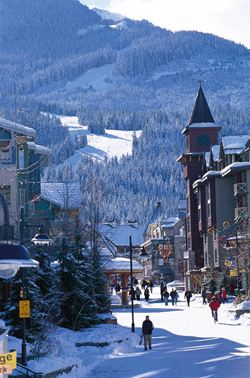 |
| Rain in Whistler Village doesn't necessarily mean rain on the mountain. |
We canât help it: Canadians are obsessed with the weather. And now with the 2010 Winter Games in Vancouver, that weather obsession borders on fanatical.
Jill Maepea sits at the eye of the storm. During the Olympics and Paralympics, the meteorologist has been tasked by Environment Canada to provide site-specific weather forecasts for the Whistler Olympic Park venue, where such sports as ski jump, biatholon and cross-country skiing take place. Forecasting is a challenge at anytime but even more so when weather systems are different depending on what part of the mountain youâre referring to.
âThe terrain of south-western British Columbia is incredibly complex, and weather can be quite different over short distances, especially in the mountains,â explains Ms. Maepea, a civilian meteorologist who usually provides weather forecasts for Canadaâs military at CFB Gagetown.
âVancouver is at sea level, Whistler Village at about 600 metres elevation, and the top of the menâs downhill about 1,800 metres. This elevation change contributes to differences in precipitation phase (rain to snow), and precipitation amounts.â
And itâs not your imagination: itâs warmer on the mountain than usual. Thatâs due to El Nino. âThe typical effects of El Nino on the Vancouver area are, on average, temperatures that are warmer and precipitation that is dryer at lower elevations. Warmer air can cause higher-than-normal snow levels. (But) a greater proportion of the total winter precipitation falls as rain at lower elevations.â
Ms. Maepea may be ideally suited for the job. Not only is she a meteorologist, sheâs also a cross-country skier who has competed at the national and international level.
From Thunder Bay, Ms. Maepea completed the one-year program, Diploma in Meteorology at HÂş». And what a year it was for a student of the weather: her time here coincided with Hurricane Juan, the category-2 hurricane which struck Halifax in September 2003, followed five months later by White Juan.
